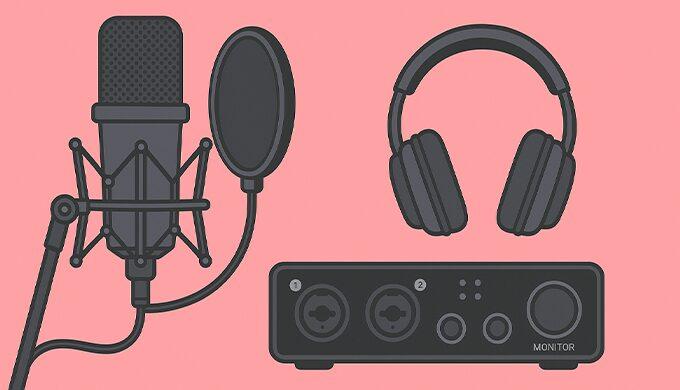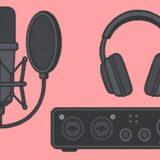目次 閉じる
- Introduction: Why Audio Is Everything for Vtubers
- 1. Why Audio Quality Makes or Breaks Your Stream
- 2. Microphone Types, Sound Differences & Choosing Your Perfect Fit
- 3. Best Mics by Budget & 2025 International Recommendations
- 4. Audio Interfaces: The Heart of Pro Streaming Sound
- 5. Cables, Accessories & Room Setup—The Invisible Sound Boosters
- 6. Room Acoustics & Streaming Studio Setup
- 7. Streaming Software & Audio Processing: Getting That “Radio-Ready” Sound
- 8. Real-World Troubleshooting & Power User Tips
- 9. Gain Staging for Perfect Sound
- 10. Mastering & Loudness for Streaming
- 11. Advanced Setups: Multi-Mic, Dual-PC, and Loopback
- 12. Music, BGM, & Copyright Basics
- 13. Stories from the Field & Latest Tech
- 14. Conclusion: Your Audio, Your Brand—Level Up Today!
Introduction: Why Audio Is Everything for Vtubers
When it comes to Vtuber streaming, audio is king.
No matter how beautiful your model or graphics, your voice is the first thing viewers connect with—and the #1 reason they stay or leave.
Professional sound quality is what separates top-tier creators from the rest.
This guide is your all-in-one manual for achieving crystal-clear, pro-level sound on any budget—whether you’re just starting or looking to level up.
1. Why Audio Quality Makes or Breaks Your Stream
Viewer Experience & Retention:
- Clear, pleasant voice = instant credibility & emotional connection.
- Distorted, noisy, or muffled audio? Most people click away, no matter your content.
- High-quality music/BGM, effects, and immersive audio boost your channel’s vibe and watch time.
The Reality:
- Nearly all successful Vtubers invest in audio first.
- “Good sound = more fans, more income”—a proven fact, not just theory.
2. Microphone Types, Sound Differences & Choosing Your Perfect Fit
Dynamic Microphones
- Pros: Durable, less sensitive to background noise, perfect for untreated rooms or live/IRL streaming.
- Best For: Chat, gaming, collabs, “busy” home environments.
- Popular Models: SHURE SM58, Elgato Wave DX, Audio-Technica ATR1300x.
Condenser Microphones
- Pros: Pick up subtle tones and nuances, ideal for singing, ASMR, narration, or expressive performances.
- Best For: Singing, storytelling, voice acting, detailed vocals.
- Popular Models: Audio-Technica AT2020/AT4040, RODE NT1-A, Lewitt LCT 440 PURE.
USB vs. XLR Microphones
- USB: Plug-and-play, no interface required, huge leap in quality over built-in mics.
Great for beginners and remote setups.
E.g. Blue Yeti, Elgato Wave 3, FIFINE K669B. - XLR: Requires audio interface, but delivers maximum audio quality and flexibility for upgrades.
E.g. AT2020 XLR, SM7B, Lewitt LCT 440 PURE.
Pickup Patterns (Polar Patterns)
- Cardioid: Captures sound from the front, blocks sides/back (great for single-person streaming).
- Omnidirectional: Captures all directions (group/roundtable streams).
- Supercardioid/Hypercardioid: Blocks even more background—best in noisy rooms.
3. Best Mics by Budget & 2025 International Recommendations
Entry Level (Up to $75~$100)
- FIFINE K669B (USB) — unbeatable value
- Audio-Technica ATR1300x (dynamic/XLR)
- RODE NT-USB Mini (USB)
- Maono AU-PM421 (USB)
Midrange ($100–$250)
- Blue Yeti (USB, switchable patterns)
- Elgato Wave 3 (USB, with powerful Wave Link software)
- SHURE SM58 (XLR, legendary durability)
- Audio-Technica AT2020 (USB/XLR)
High-End ($250+)
- Audio-Technica AT4040 (XLR, studio legend)
- SHURE SM7B (XLR, pro streamer standard)
- RODE NT1-A (XLR, super low-noise)
- Lewitt LCT 440 PURE (XLR, incredible clarity)
2025 Trends & Hot Models
- Elgato Wave DX (USB/XLR hybrid)
- HyperX ProCast (XLR, streamer favorite)
- Lewitt LCT 240 PRO (rising star for price/performance)
4. Audio Interfaces: The Heart of Pro Streaming Sound
Why You Need an Audio Interface
- Unlocks the full power of XLR microphones (and headsets)
- Controls gain, monitors audio in real-time, adds effects, and eliminates USB limitations
Top Picks for 2025 (All Globally Available)
- YAMAHA AG03/AG06 Mk2: Streamer’s classic—easy controls, built-in effects, robust build.
- Focusrite Scarlett 2i2: World-renowned clarity, stable driver support, 24bit/192kHz.
- MOTU M2/M4: Ultra-low latency, pro-level converters (ESS Sabre32), crazy transparent sound.
- Steinberg UR22C: Rock-solid, with MIDI and Cubase bundle.
- Universal Audio Volt 276: Built-in analog compressor for extra polish.
Interface Tech Deep Dive
- AD/DA Converters: Higher-end chips = more transparent sound. (ESS/Cirrus Logic/AKM explained simply.)
- Preamps: Determine how much gain (volume) and how “clean” your signal is.
Pro-Tip: Gain Staging
- Set mic input so you peak around -12 to -6dB in your streaming app.
- Don’t overload the interface or software—clean signal = best results.
5. Cables, Accessories & Room Setup—The Invisible Sound Boosters
Boom Arms
- Isolate mic from desk bumps, always perfect positioning.
- Top Picks: Elgato Wave Mic Arm, Blue Compass, Rode PSA1.
Pop Filters & Windscreens
- Block harsh “P” and “B” sounds, tame breath noise.
- Mesh (circular), foam (slips over mic), or built-in—all work well.
Cables
- Use shielded XLR cables from reputable brands (MOGAMI, Oyaide, CANARE).
- For USB, shorter is better—avoid interference from power sources.
Power & Grounding
- Use grounded outlets for all audio gear, avoid daisy-chaining power strips.
- Hum or buzz? Try an isolation transformer or ground loop eliminator.
6. Room Acoustics & Streaming Studio Setup
Sound Treatment
- Place foam panels or thick curtains behind and above your mic to absorb echo.
- For a “live” feel, only treat the wall in front of you—leave the back more open.
- A small rug or even a blanket over your desk can kill unwanted reflections.
Mic Placement
- Keep mic about a fist away from your mouth, slightly off to the side for less plosives.
- Avoid walls directly behind mic—try 12″ or more distance to reduce reflections.
Managing Noise
- Move mic away from PC fans or air conditioners.
- Use cardioid mics angled toward your mouth, not noise sources.
7. Streaming Software & Audio Processing: Getting That “Radio-Ready” Sound
OBS/Streamlabs Built-in Filters
- Noise Gate: Silences background when you’re not talking.
- Compressor: Evens out loud and quiet sections.
- Limiter: Prevents accidental loud spikes.
- EQ: Fine-tunes your tone (cut muddiness, boost clarity).
VST Plugins
- Free: ReaPlugs (ReaEQ, ReaComp, etc.)
- Pro: iZotope RX Elements (clean-up), Waves NS1, Adobe Enhance Speech.
AI Noise Reduction—2025-Style
- NVIDIA RTX Voice/Broadcast: Next-level real-time noise removal (for RTX GPUs).
- Krisp, Adobe Podcast Enhance: Cloud-based voice clean-up for any system.
- Best Practice: Combine AI with manual EQ/compression for elite results.
8. Real-World Troubleshooting & Power User Tips
Common Problems & Fixes
- Buzz/Hum: Change cables, use grounded power, try a ground loop isolator.
- Popping/Clipping: Lower input gain, use a pop filter, check OBS levels.
- Muffled Voice: Use EQ to reduce lows (<100Hz) and boost presence (3kHz–6kHz).
Signal Flow Diagrams
- Always know your chain: Mic → Interface → PC → Streaming App.
- For dual-PC or dual-mic setups, map out your wiring and test every connection.
9. Gain Staging for Perfect Sound
- Set each device so the signal is strong but never clips.
- Use streaming app meters: stay in the green, peak in yellow, never hit red.
10. Mastering & Loudness for Streaming
- YouTube: Target -14LUFS
- Twitch: Target -16LUFS
- Use a master limiter plugin to avoid distortion.
- Check your stream on mobile and headphones!
11. Advanced Setups: Multi-Mic, Dual-PC, and Loopback
- Multi-mic: Mix via a hardware mixer or advanced interface.
- Dual-PC streaming: Use line-in/out between systems, or interfaces with loopback.
- Loopback: Many modern interfaces (e.g., MOTU, Yamaha) can mix system sound and mic for seamless streaming.
12. Music, BGM, & Copyright Basics
- Use royalty-free BGM/SFX (check usage terms and crediting requirements).
- For original music: master it for streaming (balanced volume, no distortion).
- Always check copyright before streaming music—you’re responsible!
13. Stories from the Field & Latest Tech
- RTX Voice removed all keyboard and fan noise—game-changer for noisy rooms.
- Swapping to pro cables and power isolation killed 99% of mystery hums.
- Upgrading from a USB to an XLR setup (with a quality interface) shocked most streamers with the improvement.
14. Conclusion: Your Audio, Your Brand—Level Up Today!
No matter your budget or space, every streamer can achieve great sound with the right tools, tips, and a little attention to detail.
Your voice is your brand—making it shine is the best investment you can make as a Vtuber.
Start with what you have, improve step by step, and never stop learning.
Ready to sound like a pro? Go make some noise!



